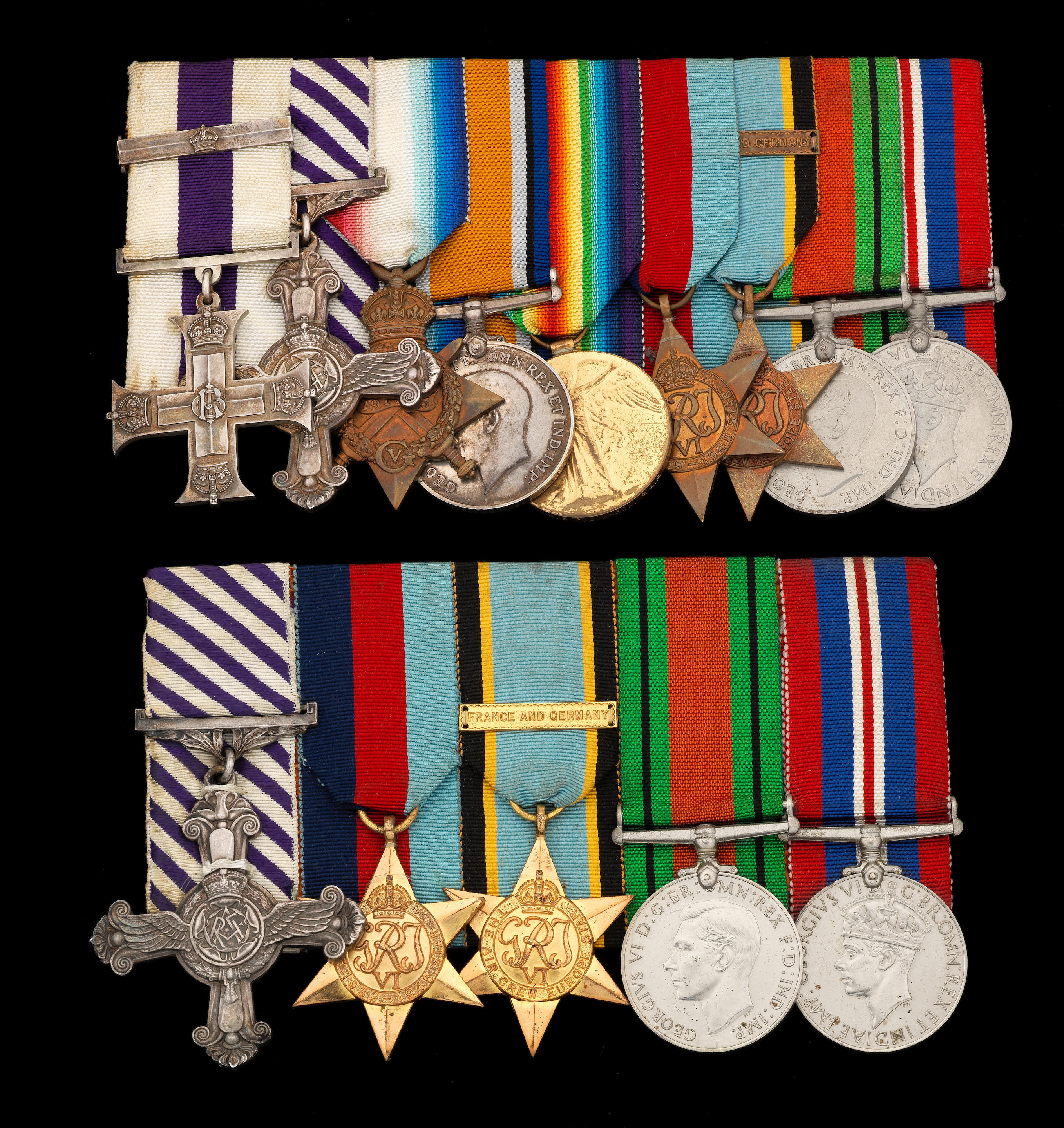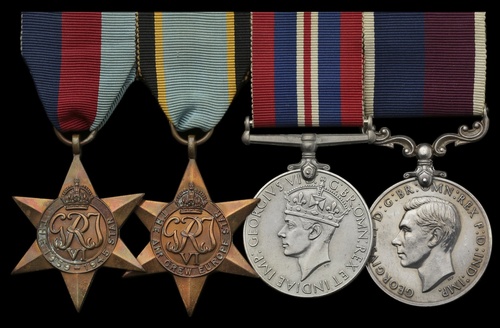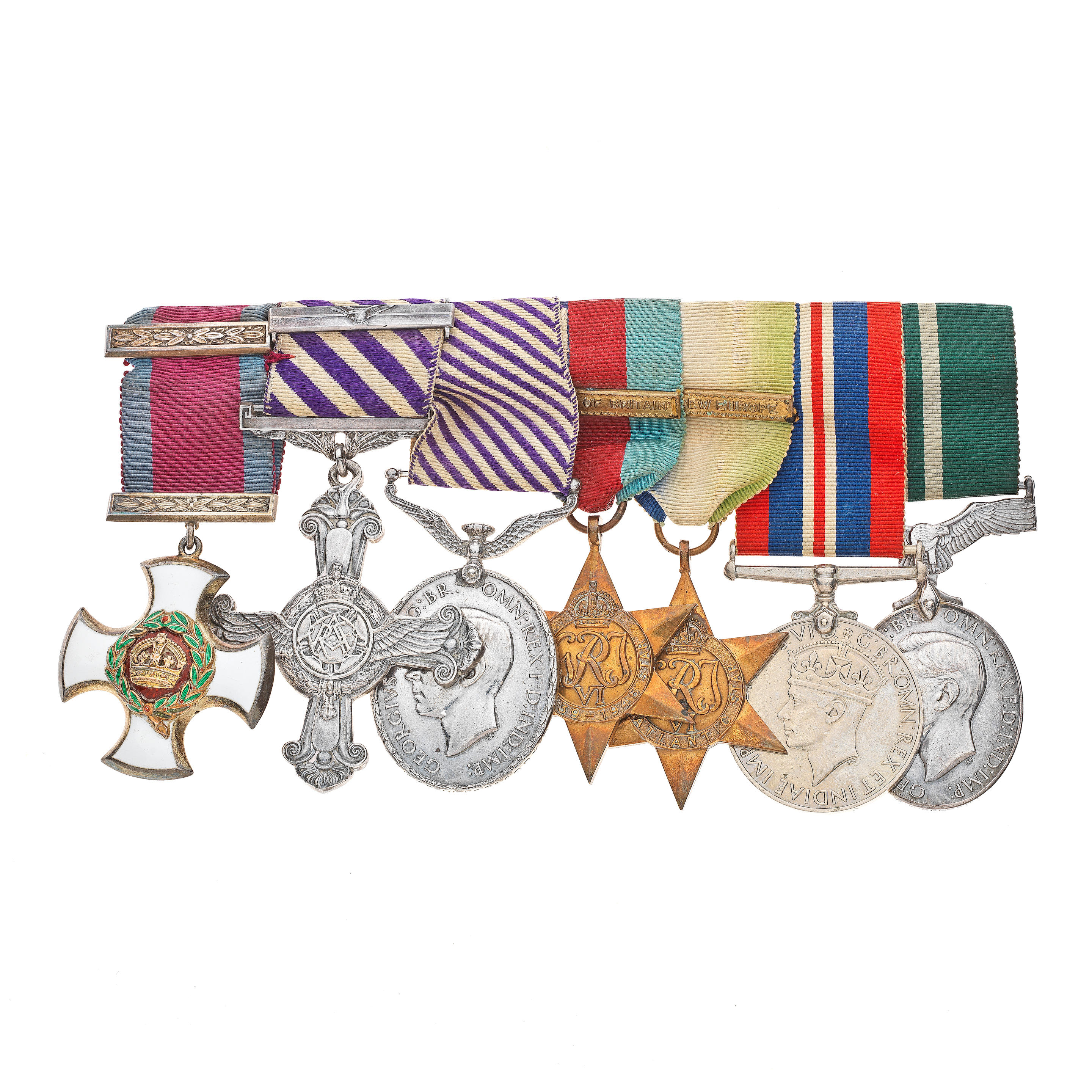An outstanding Second World War D.F.C. and Bar group of eight awarded to Flight Lieutenant D. C. Savage, Royal Air Force, who completed over 80 operational sorties in Blenheims and Bostons, many of them of the low-level variety over North-West Europe: post-war he served in the Federation of Malaya Police before rejoining the Royal Air Force and being killed during an operational sortie in Kenya during the Mau Mau troubles Distinguished Flying Cross, G.VI.R., with Second Award Bar, the reverse of the Cross officially dated ‘1943’ and the Bar ‘1944’; 1939-45 Star; Air Crew Europe Star; Africa Star, clasp, North Africa 1942-43; Italy Star; Defence and War Medals 1939-45; General Service 1918-62, 1 clasp, Malaya, G.VI.R. (581 P./Lt. D. C. Savage, F. of M. Pol.), good very fine and better (8) £3000-3500 Footnote D.F.C. London Gazette 20 April 1943. The original recommendation states: ‘This officer joined No. 88 Squadron from No. 17 O.T.U. on 9 November 1941. While with this squadron he completed 13 operational sorties of the “Circus” variety. Pilot Officer Savage took part in the search for the Scharnhorst and Gneisenau in February 1942 and, with one other aircraft of No. 88 Squadron, was engaged in smoke-laying operations during the assault on Dieppe on 19 August 1942. In one of these his only accompanying aircraft was shot down. He has two outstanding low-level attacks to his credit against Power Stations in Occupied France. The first of these, against the Comines Power Station on 29 August 1942, was pressed home to such good effect that, as the attached B.C.I.R. shows, the installation was out of action for 13 weeks. Mazingarbe Power Station was the second, and this was bombed from roof top height on 22 September 1942. Results as good as those at Comines must have been achieved, for three direct hits were scored on the boiler and turbine house, the roof of which was blow off by the explosions. In the first “Intruder” operations conducted by Boston aircraft, Pilot jOfficer Savage attacked the aerodrome at Haamstede, Holland. Here bombs were dropped from 150 feet and numerous fires were observed, one row in the middle of the aerodrome and another in the N.W. corner, as the aircraft left the target. This pilot has proved himself to be outstanding in his class and he has now completed a most successful operational tour.’ Bar to D.F.C. London Gazette 25 January 1944. The original recommendation states: ‘Flight Lieutenant Savage has been on operations since November 1941, 20 of his sorties being over Germany and Occupied France. Since the award of his Distinguished Flying Cross, he has completed a further 61 sorties both by day and by night. His exceptional keenness and skill in flying against the enemy has been an outstanding example to other members of the Squadron, and he has been one of the Squadron’s most successful night intruders, on many occasions flying in bad weather over difficult country. On frequent occasions during the Sicilian and Italian campaigns, Flight Lieutenant Savage has acted as a pathfinder for other members of the Squadron, and for other squadrons operating over the same target.’ Denis Charles Savage, who was born in Portsmouth in June 1921, enlisted in the Royal Air Force shortly after the outbreak of hostilities and, having gained his “Wings”, was posted as a Sergeant Pilot to No. 88 (Hong Kong) Squadron, a Boston unit based operating out of Attlebridge, Norfolk. No. 88 Squadron - France and Germany Having participated in the “Channel Dash” operation in February 1942, Savage completed his first bombing sortie on 14 April, when with 12 other squadron aircraft he attacked Mondeville Power Station at Caen, the first of a flurry of “Circus” and “Rover” operations. On the 17th he was detailed to attack shipyards near Rouen, on the 25th Le Havre, and on the following day St. Omer, while on the first day of May he had to take evasive action over his target, the artificial silk factory at Calais. Then in June he par
An outstanding Second World War D.F.C. and Bar group of eight awarded to Flight Lieutenant D. C. Savage, Royal Air Force, who completed over 80 operational sorties in Blenheims and Bostons, many of them of the low-level variety over North-West Europe: post-war he served in the Federation of Malaya Police before rejoining the Royal Air Force and being killed during an operational sortie in Kenya during the Mau Mau troubles Distinguished Flying Cross, G.VI.R., with Second Award Bar, the reverse of the Cross officially dated ‘1943’ and the Bar ‘1944’; 1939-45 Star; Air Crew Europe Star; Africa Star, clasp, North Africa 1942-43; Italy Star; Defence and War Medals 1939-45; General Service 1918-62, 1 clasp, Malaya, G.VI.R. (581 P./Lt. D. C. Savage, F. of M. Pol.), good very fine and better (8) £3000-3500 Footnote D.F.C. London Gazette 20 April 1943. The original recommendation states: ‘This officer joined No. 88 Squadron from No. 17 O.T.U. on 9 November 1941. While with this squadron he completed 13 operational sorties of the “Circus” variety. Pilot Officer Savage took part in the search for the Scharnhorst and Gneisenau in February 1942 and, with one other aircraft of No. 88 Squadron, was engaged in smoke-laying operations during the assault on Dieppe on 19 August 1942. In one of these his only accompanying aircraft was shot down. He has two outstanding low-level attacks to his credit against Power Stations in Occupied France. The first of these, against the Comines Power Station on 29 August 1942, was pressed home to such good effect that, as the attached B.C.I.R. shows, the installation was out of action for 13 weeks. Mazingarbe Power Station was the second, and this was bombed from roof top height on 22 September 1942. Results as good as those at Comines must have been achieved, for three direct hits were scored on the boiler and turbine house, the roof of which was blow off by the explosions. In the first “Intruder” operations conducted by Boston aircraft, Pilot jOfficer Savage attacked the aerodrome at Haamstede, Holland. Here bombs were dropped from 150 feet and numerous fires were observed, one row in the middle of the aerodrome and another in the N.W. corner, as the aircraft left the target. This pilot has proved himself to be outstanding in his class and he has now completed a most successful operational tour.’ Bar to D.F.C. London Gazette 25 January 1944. The original recommendation states: ‘Flight Lieutenant Savage has been on operations since November 1941, 20 of his sorties being over Germany and Occupied France. Since the award of his Distinguished Flying Cross, he has completed a further 61 sorties both by day and by night. His exceptional keenness and skill in flying against the enemy has been an outstanding example to other members of the Squadron, and he has been one of the Squadron’s most successful night intruders, on many occasions flying in bad weather over difficult country. On frequent occasions during the Sicilian and Italian campaigns, Flight Lieutenant Savage has acted as a pathfinder for other members of the Squadron, and for other squadrons operating over the same target.’ Denis Charles Savage, who was born in Portsmouth in June 1921, enlisted in the Royal Air Force shortly after the outbreak of hostilities and, having gained his “Wings”, was posted as a Sergeant Pilot to No. 88 (Hong Kong) Squadron, a Boston unit based operating out of Attlebridge, Norfolk. No. 88 Squadron - France and Germany Having participated in the “Channel Dash” operation in February 1942, Savage completed his first bombing sortie on 14 April, when with 12 other squadron aircraft he attacked Mondeville Power Station at Caen, the first of a flurry of “Circus” and “Rover” operations. On the 17th he was detailed to attack shipyards near Rouen, on the 25th Le Havre, and on the following day St. Omer, while on the first day of May he had to take evasive action over his target, the artificial silk factory at Calais. Then in June he par




/126696/Internet%20Image%201.jpg)
/87180/Internet%20Image%201.jpg)

/32407/Internet%20Image%201.jpg)
/87190/Internet%20Image%201.jpg)




/87182/Internet%20Image%201.jpg)
/87168/Internet%20Image%201.jpg)
Testen Sie LotSearch und seine Premium-Features 7 Tage - ohne Kosten!
Lassen Sie sich automatisch über neue Objekte in kommenden Auktionen benachrichtigen.
Suchauftrag anlegen